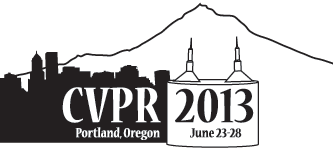-
In Defense of 3D-Label Stereo
AbstractIt is commonly believed that higher order smoothness should be modeled using higher order interactions. For example, 2nd order derivatives for deformable (active) contours are represented by triple cliques. Similarly, the 2nd order regularization methods in stereo predominantly use MRF models with scalar (1D) disparity labels and triple clique interactions. In this paper we advocate a largely overlooked alternative approach to stereo where 2nd order surface smoothness is represented by pairwise interactions with 3D-labels, e.g. tangent planes. This general paradigm has been criticized due to perceived computational complexity of optimization in higher-dimensional label space. Contrary to popular beliefs, we demonstrate that representing 2nd order surface smoothness with 3D labels leads to simpler optimization problems with (nearly) submodular pairwise interactions. Our theoretical and experimental results demonstrate advantages over state-of-the-art methods for 2nd order smoothness stereo. 1
Related Material
[pdf][bibtex]@InProceedings{Olsson_2013_CVPR,
author = {Olsson, Carl and Ulen, Johannes and Boykov, Yuri},
title = {In Defense of 3D-Label Stereo},
booktitle = {Proceedings of the IEEE Conference on Computer Vision and Pattern Recognition (CVPR)},
month = {June},
year = {2013}
}
These CVPR 2013 papers are the Open Access versions, provided by the Computer Vision Foundation.
Except for the watermark, they are identical to the accepted versions; the final published version of the proceedings is available on IEEE Xplore.
Except for the watermark, they are identical to the accepted versions; the final published version of the proceedings is available on IEEE Xplore.
This material is presented to ensure timely dissemination of scholarly and technical work.
Copyright and all rights therein are retained by authors or by other copyright holders.
All persons copying this information are expected to adhere to the terms and constraints invoked by each author's copyright.

